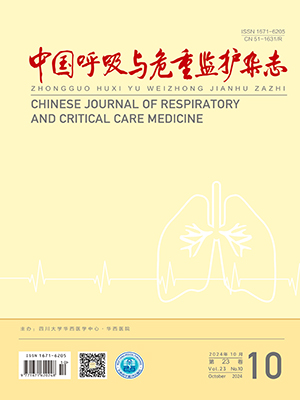| 1. |
葛慧青, 孙兵, 王波, 等. 重症患者气道廓清技术专家共识. 中华重症医学电子杂志(网络版), 2020, 6(3): 272-282.
|
| 2. |
Strickland SL, Rubin BK, Drescher GS, et al. AARC clinical practice guideline: effectiveness of nonpharmacologic airway clearance therapies in hospitalized patient. Respir Care, 2013, 58(12): 2187-2193.
|
| 3. |
王拥军, 陈玉国, 吕传柱, 等. 卒中相关性肺炎诊治中国专家共识(2019 更新版). 中国卒中杂志, 2019, 14(12): 1251-1262.
|
| 4. |
Westerdahl E, Osadnik C, Emtner M. Airway clearance techniques for patients with acute exacerbations of chronic obstructive pulmonary disease: physical therapy practice in Sweden. Chron Respir Dis, 2019, 16: 511-518.
|
| 5. |
石宏哲, 秦铮, 池卫华, 等. 重症肺炎 MSCT 图像征象、临床肺部感染评分与病情严重程度的相关性研究. 中国 CT 和 MRI 杂志, 2019, 17(7): 79-81.
|
| 6. |
Ewig S, Höffken G, Kern WV, et al. Behandlung von erwachsenen Patienten mit ambulant erworbener Pneumonie und Prävention - Update 2016 [Management of Adult Community-acquired Pneumonia and Prevention - Update 2016]. Pneumologie, 2016, 70(3): 151-200.
|
| 7. |
丁玉菊, 徐绍侠, 张伟, 等. 神经重症气管切开患者拔管临床指征的Meta分析. 中华危重病急救医学, 2019, 31(11): 1378-1383.
|
| 8. |
Hilker R, Poetter C, Findeisen N, et al. Nosocomial pneumonia after acute stroke: implications for neurological intensive care medicine. Stroke, 2003, 34(4): 975-981.
|
| 9. |
Smith CJ, Kishore AK, Vail A, et al. Diagnosis of stroke-associated pneumonia: recommendations from the Pneumonia in Stroke Consensus Group. Stroke, 2015, 46(8): 2335-2340.
|
| 10. |
Sari IM, Soertidewi L, Yokota C, et al. Comparison of characteristics of stroke-associated pneumonia in stroke care units in Indonesia and Japan. J Stroke Cerebrovasc Dis, 2017, 26(2): 280-285.
|
| 11. |
Teh WH, Smith CJ, Barlas RS, et al. Impact of stroke-associated pneumonia on mortality, length of hospitalization, and functional outcome. Acta Neurol Scand, 2018, 138(4): 293-300.
|
| 12. |
Barlas RS, Clark AB, Bettencourt-Silva JH, et al. Pneumonia and risk of serious adverse outcomes in hospitalized strokes in Thailand. J Stroke Cerebrovasc Dis, 2019, 28(6): 1448-1454.
|
| 13. |
Ali AN, Howe J, Majid A, et al. The economic cost of stroke-associated pneumonia in a UK setting. Top Stroke Rehabil, 2018, 25(3): 214-223.
|
| 14. |
Lakshminarayan K, Tsai AW, Tong X, et al. Utility of dysphagia screening results in predicting poststroke pneumonia. Stroke, 2010, 41(12): 2849-2854.
|
| 15. |
Sui R, Zhang L. Risk factors of stroke-associated pneumonia in Chinese patients. Neurol Res, 2011, 33(5): 508-513.
|
| 16. |
Bosel J. Tracheostomy in stroke patients. Curr Treat Options Neurol, 2014, 16(1): 274.
|
| 17. |
Su X, Li Z, Wang M, et al. The protective effect of different airway humidification liquids to lung after tracheotomy in traumatic brain injury: the role of pulmonary surfactant protein-A (SP-A). Gene, 2016, 577(1): 89-95.
|
| 18. |
Dziewas R, Stellato R, van der Tweel I, et al. Pharyngeal electrical stimulation for early decannulation in tracheotomised patients with neurogenic dysphagia after stroke (PHAST-TRAC): a prospective, single-blinded, randomised trial. Lancet Neurol, 2018, 17(10): 849-859.
|
| 19. |
Perin C, Meroni R, Rega V, et al. Parameters influencing tracheostomy decannulation in patients undergoing rehabilitation after severe acquired brain injury (sABI). Int Arch Otorhinolaryngol, 2017, 21(4): 382-389.
|
| 20. |
Park MK, Lee SJ. Changes in swallowing and cough functions among stroke patients before and after tracheostomy decannulation. Dysphagia, 2018, 33(6): 857-865.
|
| 21. |
黄岳, 崔利华, 刘丽旭, 等. 脑卒中患者的呼吸功能障碍及其康复. 中国康复理论与实践, 2015, 2l(9): 1055-1057.
|
| 22. |
谭旭, 许娟, 罗薇娜, 等. 两种气道廓清技术在慢性阻塞性肺疾病急性加重病人中的应用效果比较. 护理研究, 2020, 34(9): 1662-1665.
|
| 23. |
华玉平, 冯重睿, 符碧洲, 等. 探讨主动呼吸循环技术对脑卒中气管切开术后患者呼吸功能的疗效. 中国康复, 2018, 33(2): 136-137.
|
| 24. |
Enrichi C, Battel I, Zanetti C, et al. Clinical criteria for tracheostomy decannulation in subjects with acquired brain injury. Respir Care, 2017, 62(10): 1255-1263.
|
| 25. |
高天敏, 周全昌, 黄仕聪, 等. 三球式呼吸训练器在慢性阻塞性肺疾病患者肺康复中的应用研究. 重庆医学, 2015, 44(32): 4514-4516.
|
| 26. |
李群, 陈锋, 王晓霞, 等. 肺康复训练对不同严重度稳定期慢性阻塞性肺疾病的影响. 中国呼吸与危重监护杂志, 2013, 12(2): 130-135.
|
| 27. |
Flude LJ, Agent P, Bilton D. Chest physiotherapy techniques in bronchiectasis. Clin Chest Med, 2012, 33(2): 351-361.
|




